coolant temperature Acura TL 2000 3.2 Owner's Manual
[x] Cancel search | Manufacturer: ACURA, Model Year: 2000, Model line: TL, Model: Acura TL 2000Pages: 311, PDF Size: 3.05 MB
Page 63 of 311
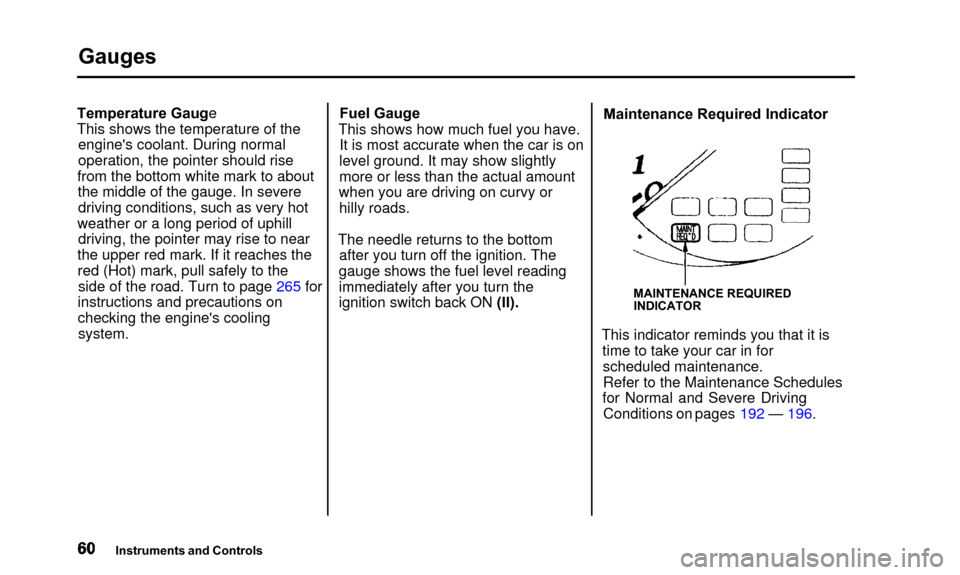
Gauges
Temperature Gauge
This shows the temperature of theengine's coolant. During normal
operation, the pointer should rise
from the bottom white mark to about the middle of the gauge. In severedriving conditions, such as very hot
weather or a long period of uphill driving, the pointer may rise to near
the upper red mark. If it reaches the red (Hot) mark, pull safely to theside of the road. Turn to page 265 for
instructions and precautions on
checking the engine's cooling system. Fuel Gauge
This shows how much fuel you have. It is most accurate when the car is on
level ground. It may show slightly
more or less than the actual amount
when you are driving on curvy or hilly roads.
The needle returns to the bottom after you turn off the ignition. The
gauge shows the fuel level reading
immediately after you turn the
ignition switch back ON (II). Maintenance Required Indicator
MAINTENANCE REQUIRED
INDICATOR
This indicator reminds you that it is
time to take your car in forscheduled maintenance.Refer to the Maintenance Schedules
for Normal and Severe Driving Conditions on pages 192 — 196.
Instruments and Controls
Page 197 of 311
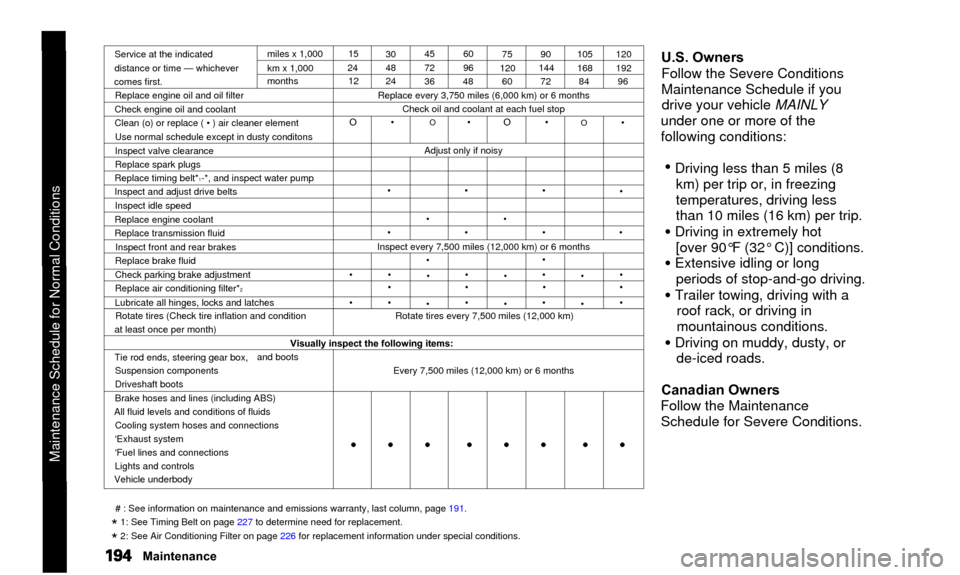
Service at the indicated
distance or time — whichever
comes first. miles x 1,000
km x 1,000
months
Replace engine oil and oil filter
Check engine oil and coolant
Clean (o) or replace ( • ) air cleaner element Use normal schedule except in dusty conditons
Inspect valve clearance
Replace spark plugs
Replace timing belt*
1-*, and inspect water pump
Inspect and adjust drive belts
Inspect idle speed
Replace engine coolant
Replace transmission fluid Inspect front and rear brakes
Replace brake fluid
Check parking brake adjustment
Replace air conditioning filter*
2Lubricate all hinges, locks and latches Rotate tires (Check tire inflation and condition
at least once per month) 15
24 12 30
48
24 45
72
3660
96
48 75
120 60 90
144
72 105
168
84 120
192
96
Replace every 3,750 miles (6,000 km) or 6 months Check oil and coolant at each fuel stop
O •
O • O •
Adjust only if noisy
•
•
•
•
•
•
•
•
O •
•
•
Inspect every 7,500 miles (12,000 km) or 6 months
•
• •
•
•
•
•
••
•
••
•
•
• •
•
•
••
•
•
Rotate tires every 7,500 miles (12,000 km)
Visually inspect the following items:
Tie rod ends, steering gear box, Suspension components
Driveshaft boots and boots
Brake hoses and lines (including ABS)
All fluid levels and conditions of fluids Cooling system hoses and connections
'Exhaust system
'Fuel lines and connections
Lights and controls
Vehicle underbody Every 7,500 miles (12,000 km) or 6 months
U.S. Owners
Follow the Severe Conditions
Maintenance Schedule if you
drive your vehicle MAINLY
under one or more of the
following conditions:
• Driving less than 5 miles (8 km) per trip or, in freezing
temperatures, driving less
than 10 miles (16 km) per trip.
• Driving in extremely hot[over 90°F (32° C)] conditions.
• Extensive idling or long periods of stop-and-go driving.
• Trailer towing, driving with a roof rack, or driving in
mountainous conditions.
• Driving on muddy, dusty, orde-iced roads.
Canadian Owners
Follow the Maintenance Schedule for Severe Conditions.
# : See information on maintenance and emissions warranty, last column, \
page 191.
* 1: See Timing Belt on page 227 to determine need for replacement.
* 2: See Air Conditioning Filter on page 226 for replacement information under special conditions.
Maintenance
Maintenance Schedule for Normal Conditions• • • • • • • \
•
Page 198 of 311
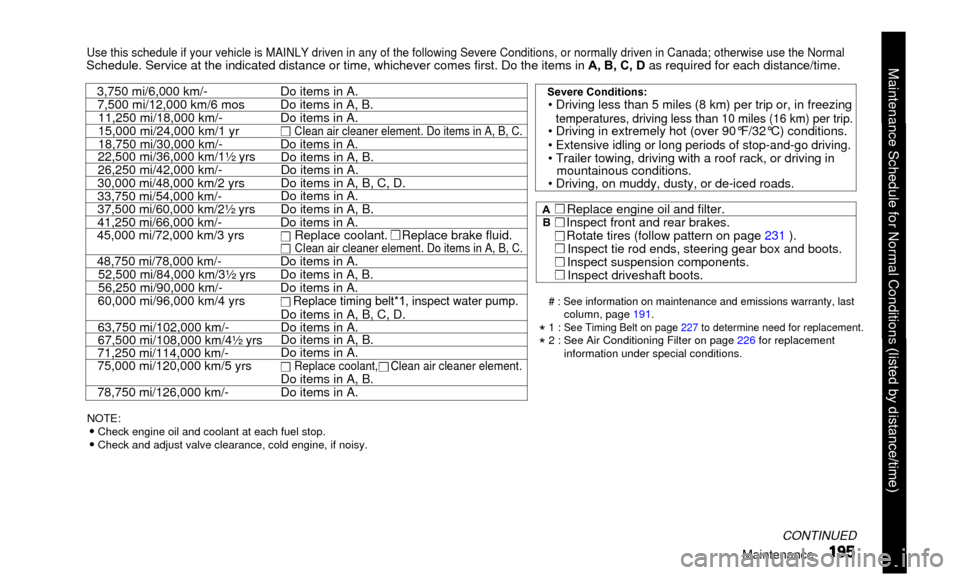
Use this schedule if your vehicle is MAINLY driven in any of the followi\
ng Severe Conditions, or normally driven in Canada; otherwise use the No\
rmalSchedule. Service at the indicated distance or time, whichever comes fir\
st. Do the items in A, B, C, D as required for each distance/time.
3,750 mi/6,000 km/-7,500 mi/12,000 km/6 mos 11,250 mi/18,000 km/-
15,000 mi/24,000 km/1 yr
18,750 mi/30,000 km/-
22,500 mi/36,000 km/1½ yrs
26,250 mi/42,000 km/-
30,000 mi/48,000 km/2 yrs
33,750 mi/54,000 km/-
37,500 mi/60,000 km/2½ yrs
41,250 mi/66,000 km/-
45,000 mi/72,000 km/3 yrs
48,750 mi/78,000 km/-
52,500 mi/84,000 km/3½ yrs
56,250 mi/90,000 km/-
60,000 mi/96,000 km/4 yrs
63,750 mi/102,000 km/-
67,500 mi/108,000 km/4½ yrs
71,250 mi/114,000 km/-
75,000 mi/120,000 km/5 yrs
78,750 mi/126,000 km/- Do items in A.
Do items in A, B. Do items in A.
CIean air cleaner element. Do items in A, B, C.Do items in A. Do items in A, B.Do items in A.
Do items in A, B, C, D.
Do items in A.
Do items in A, B.
Do items in A. Replace coolant. Replace brake fluid.
CIean air cleaner element. Do items in A, B, C.Do items in A.
Do items in A, B.
Do items in A.
'
Replace timing belt*1, inspect water pump.Do items in A, B, C, D.
Do items in A.
Do items in A, B.
Do items in A.
Replace coolant, Clean air cleaner element.Do items in A, B.
Do items in A.
NOTE:• Check engine oil and coolant at each fuel stop.• Check and adjust valve clearance, cold engine, if noisy.
CONTINUED
Maintenance
Severe Conditions:• Driving less than 5 miles (8 km) per trip or, in freezingtemperatures, driving less than 10 miles (16 km) per trip.• Driving in extremely hot (over 90°F/32°C) conditions.
• Extensive idling or long periods of stop-and-go driving.• Trailer towing, driving with a roof rack, or driving in mountainous conditions.
• Driving, on muddy, dusty, or de-iced roads.
A
B• Replace engine oil and filter. Inspect front and rear brakes.
Rotate tires (follow pattern on page 231 ). Inspect tie rod ends, steering gear box and boots.
Inspect suspension components. Inspect driveshaft boots.
# : See information on maintenance and emissions warranty, lastcolumn, page 191.
* 1 : See Timing Belt on page 227 to determine need for replacement.
* 2 : See Air Conditioning Filter on page 226 for replacement
information under special conditions.
Maintenance Schedule for Normal Conditions (listed by distance/time)
Page 212 of 311

Cooling System
1. Turn the ignition ON (II). Turnthe heater temperature controldial to maximum heat (climate
control to 90°F/32°C). Turn off
the ignition. Open the hood. Make sure the engine and radiator are
cool to the touch.
2. Remove the radiator cap.
DRAIN PLUG
DRAIN BOLT
3. Loosen the drain plug on thebottom of the radiator. Thecoolant will drain through thesplash guard. Loosen the drain
bolt at the rear of the engine cylinder block.
RESERVE TANK CAP RESERVE TANK
HOLDER
4. Remove the reserve tank from itsholder by pulling it straight up.Drain the coolant, then put the
tank back in its holder.
5. When the coolant stops draining, tighten the drain plug at the
bottom of the radiator.
CONTINUED
Maintenance
Page 268 of 311
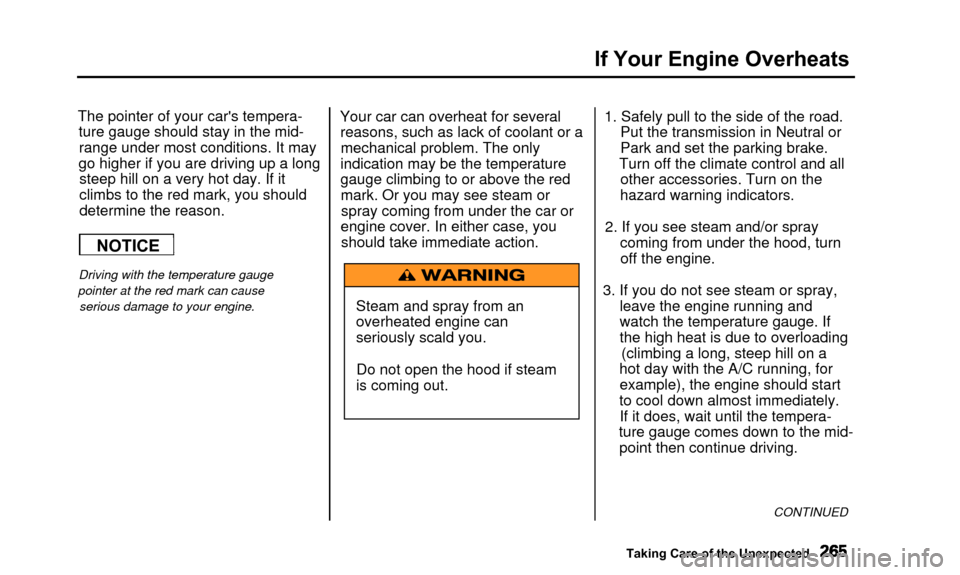
If Your Engine Overheats
The pointer of your car's tempera-ture gauge should stay in the mid-range under most conditions. It may
go higher if you are driving up a long steep hill on a very hot day. If it
climbs to the red mark, you should
determine the reason.
Driving with the temperature gauge
pointer at the red mark can cause serious damage to your engine.
Your car can overheat for severalreasons, such as lack of coolant or amechanical problem. The only
indication may be the temperature
gauge climbing to or above the red mark. Or you may see steam orspray coming from under the car or
engine cover. In either case, you should take immediate action.
Steam and spray from an
overheated engine can
seriously scald you.Do not open the hood if steam
is coming out. 1. Safely pull to the side of the road.
Put the transmission in Neutral or
Park and set the parking brake.
Turn off the climate control and all other accessories. Turn on the
hazard warning indicators.
2. If you see steam and/or spray coming from under the hood, turnoff the engine.
3. If you do not see steam or spray, leave the engine running and
watch the temperature gauge. If
the high heat is due to overloading(climbing a long, steep hill on a
hot day with the A/C running, for example), the engine should start
to cool down almost immediately. If it does, wait until the tempera-
ture gauge comes down to the mid- point then continue driving.
CONTINUED
Taking Care of the Unexpected
NOTICE
Page 269 of 311
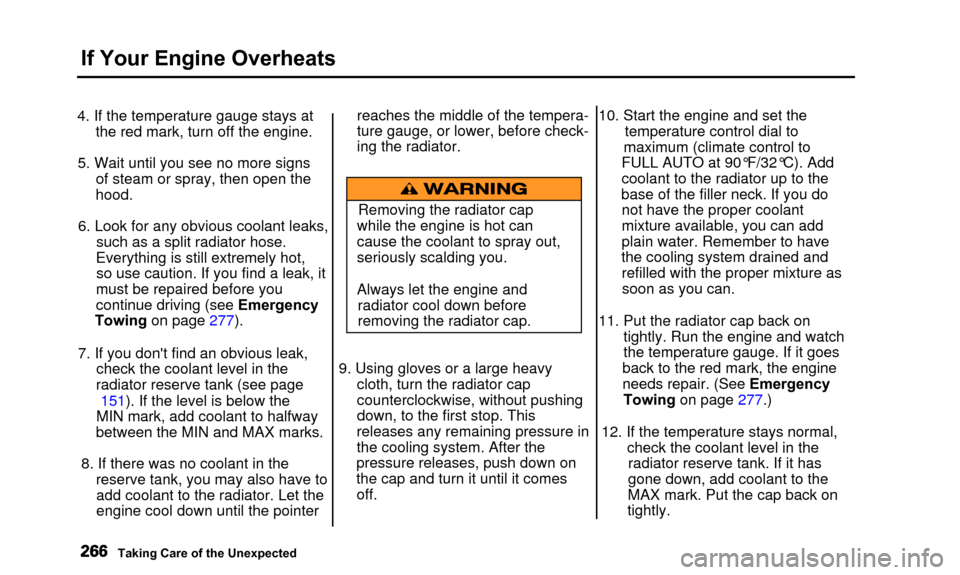
If Your Engine Overheats
4. If the temperature gauge stays atthe red mark, turn off the engine.
5. Wait until you see no more signs of steam or spray, then open the
hood.
6. Look for any obvious coolant leaks, such as a split radiator hose.
Everything is still extremely hot, so use caution. If you find a leak, it
must be repaired before you
continue driving (see Emergency
Towing on page 277).
7. If you don't find an obvious leak, check the coolant level in the
radiator reserve tank (see page
151). If the level is below the
MIN mark, add coolant to halfway
between the MIN and MAX marks.
8. If there was no coolant in the reserve tank, you may also have toadd coolant to the radiator. Let the
engine cool down until the pointer reaches the middle of the tempera-
ture gauge, or lower, before check-
ing the radiator.
Removing the radiator cap
while the engine is hot can
cause the coolant to spray out,
seriously scalding you.
Always let the engine and radiator cool down before
removing the radiator cap.
9. Using gloves or a large heavy cloth, turn the radiator cap
counterclockwise, without pushing
down, to the first stop. This
releases any remaining pressure in
the cooling system. After the
pressure releases, push down on
the cap and turn it until it comes off. 10. Start the engine and set the
temperature control dial to
maximum (climate control to
FULL AUTO at 90°F/32°C). Add
coolant to the radiator up to the
base of the filler neck. If you do not have the proper coolant
mixture available, you can add
plain water. Remember to have
the cooling system drained and refilled with the proper mixture assoon as you can.
11. Put the radiator cap back on tightly. Run the engine and watch
the temperature gauge. If it goes
back to the red mark, the engine
needs repair. (See Emergency
Towing on page 277
.)
12. If the temperature stays normal, check the coolant level in theradiator reserve tank. If it has
gone down, add coolant to the
MAX mark. Put the cap back on
tightly.
Taking Care of the Unexpected
Page 304 of 311
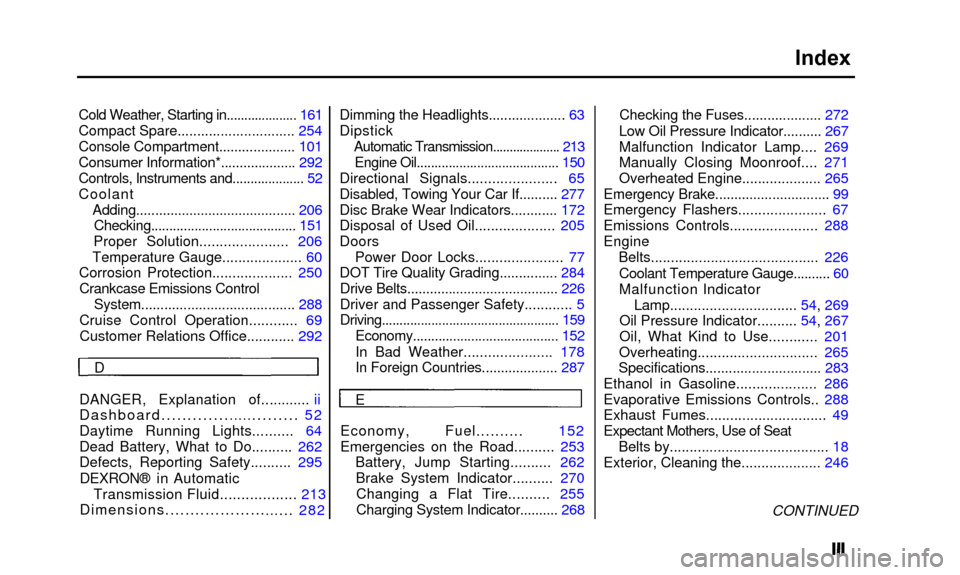
Index
Cold Weather, Starting in.................... 161
Compact Spare.............................. 254
Console Compartment.......... .......... 101
Consumer Information*.......... .......... 292
Controls, Instruments and.................... 52
Coolant
Adding.......................................... 206 Checking........................................ 151
Proper Solution...................... 206
Temperature Gauge.................... 60
Corrosion Protection.......... .......... 250
Crankcase Emissions Control System........................................ 288
Cruise Control Operation.......... .. 69
Customer Relations Office............ 292 Dimming the Headlights.........
........... 63
Dipstick Automatic Transmission.......... .......... 213
Engine Oil.......... .............................. 150
Directional Signals......... ............. 65
Disabled, Towing Your Car If.......... 277
Disc Brake Wear Indicators............ 172
Disposal of Used Oil.......... .......... 205
Doors Power Door Locks......... ............. 77
DOT Tire Quality Grading.......... ..... 284
Drive Belts.......... .............................. 226
Driver and Passenger Safety............ 5
Driving.................................................. 159
Economy........................................ 152
In Bad Weather.......... ............ 178
In Foreign Countries.................... 287 Checking the Fuses.................... 272
Low Oil Pressure Indicator.......... 267
Malfunction Indicator Lamp.... 269
Manually Closing Moonroof.... 271
Overheated Engine..........
.......... 265
Emergency Brake.............................. 99
Emergency Flashers...................... 67
Emissions Controls...................... 288
Engine Belts.......................................... 226
Coolant Temperature Gauge.......... 60
Malfunction IndicatorLamp................................ 54, 269
Oil Pressure Indicator.......... 54, 267
Oil, What Kind to Use.......... .. 201
Overheating.............................. 265
Specifications.......... .................... 283
Ethanol in Gasoline.................... 286
Evaporative Emissions Controls.. 288
Exhaust Fumes......... ..................... 49
Expectant Mothers, Use of Seat Belts by........................................ 18
Exterior, Cleaning the.......... .......... 246
CONTINUED
D
DANGER, Explanation of...
......... ii
Dashboard.............
.............. 52
Daytime Running Lights.......... 64
Dead Battery, What to Do.......... 262
Defects, Reporting Safety.......... 295
DEXRON® in Automatic Transmission Fluid.................. 213
Dimensions....................
...... 282 E
Economy, Fuel.......... 152
Emergencies on the Road.......... 253 Battery, Jump Starting.......... 262Brake System Indicator.......... 270Changing a Flat Tire.......... 255Charging System Indicator.......... 268
Page 305 of 311
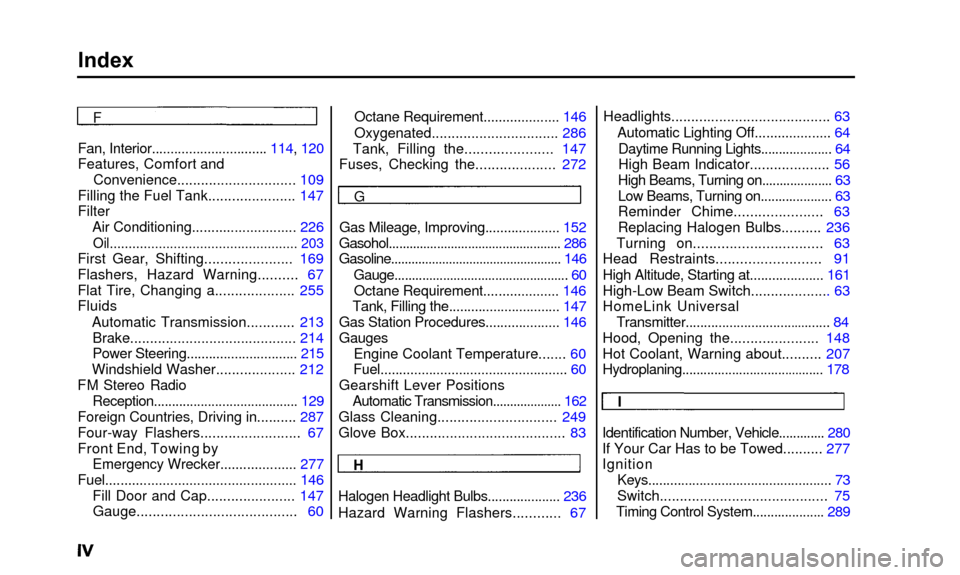
Index
Fan, Interior............................... 114, 120
Features, Comfort andConvenience.............................. 109
Filling the Fuel Tank...................... 147
Filter Air Conditioning.......... ................. 226
Oil.................................................. 203
First Gear, Shifting.......... ............ 169
Flashers, Hazard Warning.......... 67
Flat Tire, Changing a.................... 255
Fluids
Automatic Transmission.. .......... 213
Brake.......... ................................ 214
Power Steering.............................. 215
Windshield Washer.................... 212
FM Stereo Radio Reception........................................ 129
Foreign Countries, Driving in.......... 287
Four-way Flashers......................... 67
Front End, Towing by
Emergency Wrecker.................... 277
Fuel.................................................. 146
Fill Door and Cap...................... 147 Gauge........................................ 60 Octane Requirement..........
.......... 146
Oxygenated.......... ...................... 286
Tank, Filling the.......... ............ 147
Fuses, Checking the.......... .......... 272Headlights.......................................
. 63
Automatic Lighting Off.................... 64 Daytime Running Lights......... ........... 64
High Beam Indicator.................... 56
High Beams, Turning on......... ........... 63
Low Beams, Turning on......... ........... 63
Reminder Chime...................... 63
Replacing Halogen Bulbs.......... 236
Turning on......... ....................... 63
Head Restraints.......................... 91
High Altitude, Starting at.......... .......... 161
High-Low Beam Switch......... ........... 63
HomeLink Universal Transmitter.............................
.......... . 84
Hood, Opening the...................... 148
Hot Coolant, Warning about.......... 207
Hydroplaning.............................
........... 178
F
G
Gas Mileage, Improving.......... .......... 152
Gasohol.................................................. 286
Gasoline.................................................. 146
Gauge......... ........................................ . 60
Octane Requirement.......... .......... 146
Tank, Filling the.......... .................... 147
Gas Station Procedures.................... 146
Gauges
Engine Coolant Temperature... .... 60
Fuel................................................. . 60
Gearshift Lever Positions Automatic Transmission.................... 162
Glass Cleaning.............................. 249
Glove Box....................................... . 83
H
Halogen Headlight Bulbs.................... 236
Hazard Warning Flashers.......... .. 67I
Identification Number, Vehicle............. 280
If Your Car Has to be Towed.......... 277
Ignition
Keys................................................. . 73
Switch......................................... . 75
Timing Control System.......... .......... 289